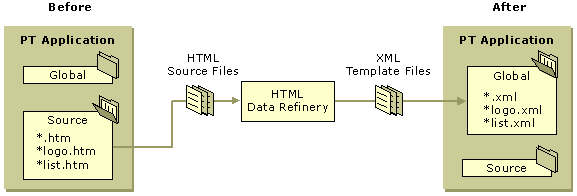
Each screen the PT application presents to the user consists of four frames. The basic screen consists of a logo frame at the top, a horizontal menu frame that holds the application's menus, a left pane for lists of individuals, groups, activities, activity types, and locations, and a right pane to display the data about the item selected from the list.
When the application runs, each of these frames is populated by an HTML file, which is created on the server by merging a nonlocalized XML file with the Lingo.xml file for the browser's language.
The application includes XML files for the logo, menu, left pane, and right pane frames for each application screen. These XML files are designed as HTML pages, and then converted to XML with the HTML Data Refinery tool included on the BackOffice® Developer's Guide CD. Because HTML is a subset of XML, this conversion is relatively simple. HTML, however, does not enforce rules as strictly as does XML. While HTML is a subset of XML, it is not necessarily well-formed XML, or XML that conforms to the W3C XML 1.0 specification. Here is a distilled list of the requirements for well-formed XML:
In addition, the HTML Data Refinery tool generates case-consistent XML, even though it does not use a DTD or schema to enforce XML's case-sensitivity. The tool works from the in-memory representation of HTML, so it uses the case designated by the HTML Document Object Model: Tags use uppercase and attributes use mixed case.
The following illustration shows how HTML source files are processed into globalized XML template files. The tool loads in-memory representations of the HTML files contained in the application's Source directory, modifies them, and saves them as globalized XML template files in the application's Global directory. See HTML Data Refinery for information about using this tool.

The HTML Data Refinery tool modifies HTML files so that they conform to the XML rules. Currently, few tools exist for authoring XML documents. The HTML Data Refinery tool allowed the LitWare developers to avoid the onerous task of hand-modifying the HTML code they created using Microsoft Visual InterDev® to turn it into well-formed XML.
After these XML files are created, they are placed in the PT application's Global directory, later to be merged with the content residing in the lingo.xml file when a user builds application pages for a specific locale.